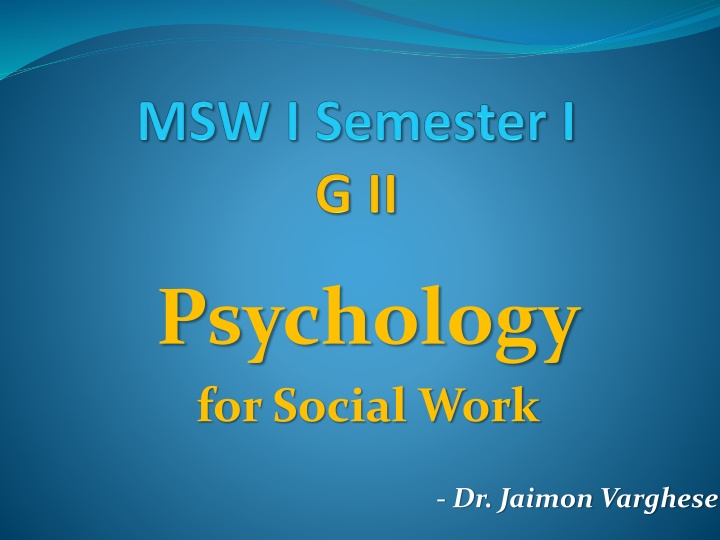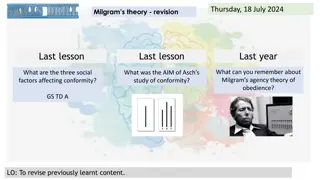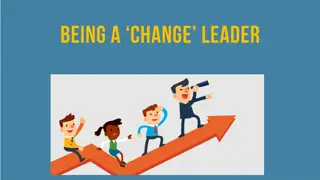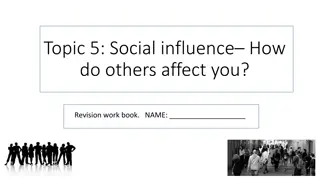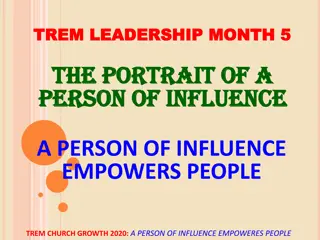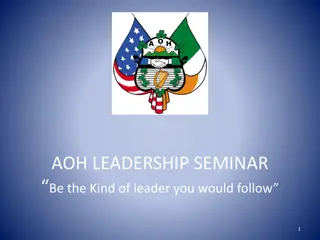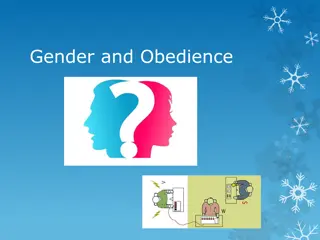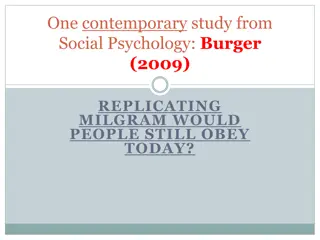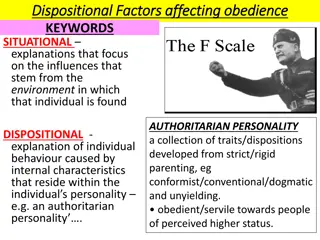Leadership Insights: Inspiring Obedience and Effective Influence
In the realm of leadership, inspiring willing obedience and extraordinary performance is crucial. Leaders must embody qualities that earn respect and foster genuine followership without resorting to mere authority. Key elements include integrity, resilience, fairness, and humility, alongside the importance of knowledge and being good at various aspects of leadership. Upholding these principles leads to trust and engagement within a team, enabling leaders to have a positive impact. True leadership goes beyond titles – it's about influence, competence, and continuous self-improvement.
Download Presentation

Please find below an Image/Link to download the presentation.
The content on the website is provided AS IS for your information and personal use only. It may not be sold, licensed, or shared on other websites without obtaining consent from the author.If you encounter any issues during the download, it is possible that the publisher has removed the file from their server.
You are allowed to download the files provided on this website for personal or commercial use, subject to the condition that they are used lawfully. All files are the property of their respective owners.
The content on the website is provided AS IS for your information and personal use only. It may not be sold, licensed, or shared on other websites without obtaining consent from the author.
E N D
Presentation Transcript
Psychology for Social Work - Dr. Jaimon Varghese
3. Psychological & Social Processes in Behaviour 3.1. Learning and motivation 3.2. Emotions 3.3. Perception 3.4. Attitudes, 3.5 Prejudices, Biases & Stereotyping 02-03-2025 14:57:48 Psychology for Social Workers 2
3.1. Learning and motivation 3.1.1 Learning 3.1.2 Motivation 02-03-2025 14:57:48 Psychology for Social Workers 3
3.1.1 Learning A relatively permanent change in cognition, knowledge or behaviour or the cognitive process of acquiring skill or knowledge through study, experience or teaching 02-03-2025 14:57:49 Psychology for Social Workers 4
3.1.1. Learning Learning is an essential aspect of behaviour Learning is the increase in the amount of concepts in the memory of an individual. Simon defined learning as changes in a system that result in improved performance over time on tasks similar to those done previously. It suggests continuous and cumulative improvement 02-03-2025 14:57:49 Psychology for Social Workers 5
3.1.1 Learning Learning is the process which develops or changes the behaviour of the learner to a degree of permanence, usually with the intervention of an educator. Learning involves the child in totality and relates to the acquisition of facts and modification of concepts, principles, attitudes, emotions and skills. Learning refers to acquiring new concepts, new skills and new knowledge to perform a job. 02-03-2025 14:57:49 Psychology for Social Workers 6
3.1.1 Learning Any activity can be called learning so far as it develops the individual and makes him alter behaviour and experiences different from what that would otherwise have been (Woodworth, 1945) Learning is the acquisition of new behaviour or the strengthening or weakening of old behaviour as the result of experience (Henry P Smith, 1962) The term learning covers the very modification in behaviour to meet environmental requirements (Gardner Murphy, 1968) 02-03-2025 14:57:49 Psychology for Social Workers 7
3.1.1 Learning Gagne (1985) identifies five major categories of learning: verbal information, intellectual skills, cognitive strategies, motor skills and attitudes. 02-03-2025 14:57:49 Psychology for Social Workers 8
3.1.1 Learning Gagne suggests that learning tasks for intellectual skills can be organized in a hierarchy according to complexity: stimulus recognition, response generation, procedure following, use of terminology, discriminations, concept formation, rule application, and problem solving. 02-03-2025 14:57:49 Psychology for Social Workers 9
3.1.1 Learning: theories 1. Connectionism (Thorndike, E (1913) Educational Psychology: The Psychology of Learning, New York: Teachers College Press) Thorndike's theory consists of three primary laws: (1) law of effect - responses to a situation which are followed by a rewarding state of affairs will be strengthened and become habitual responses to that situation, (2) law of readiness - a series of responses can be chained together to satisfy some goal which will result in annoyance if blocked, and (3) law of exercise - connections become strengthened with practice and weakened when practice is discontinued. A corollary of the law of effect was that responses that reduce the likelihood of achieving a rewarding state (i.e., punishments, failures) will decrease in strength. 02-03-2025 14:57:49 Psychology for Social Workers 10
3.1.1 Learning theories 2. Drive Reduction Theory (Hull, C. (1943) Principles of Behaviour, New York: Appleton-Century-Crofts): Drive is essential in order for responses to occur (i.e., the student must want to learn). Learning must satisfy the learner's wants). 3. Gestalt Theory (Wertheimer, M (1959) Productive Thinking, New York: Harper & Row):the idea of "grouping , forming a gestalt (pattern or fullness), insightful problem-solving. 4. Classical conditioning of Ian Pavlov: Stimulus Response Theory 5. Operant conditioning of BF Skinner: Reward and punishment; behaviour modification [Skinner, B.F. (1954) The science of learning and the art of teaching, Harvard Educational Review, 24(2), 86-97] 02-03-2025 14:57:49 Psychology for Social Workers 11
3.1.1 Learning theories 6. Social Learning Theory [Bandura, A. (1977) Social Learning Theory, New York: General Learning Press]: most human behaviour is learned observationally through modelling: from observing others one forms an idea of how new behaviours are performed The component processes underlying observational learning are: (1) Attention, including modelled events (distinctiveness, affective valence, complexity, prevalence, functional value) and observer characteristics (sensory capacities, arousal level, perceptual set, past reinforcement), (2) Retention, including symbolic coding, cognitive organization, symbolic rehearsal, motor rehearsal), (3) Motor Reproduction, including physical capabilities, self-observation of reproduction, accuracy of feedback, and (4) Motivation, including external, vicarious and self reinforcement. 02-03-2025 14:57:49 Psychology for Social Workers 12
3.1.1 Learning Transfer of learning: positive, negative & zero transfer Factors influencing learning: Knowledge of results and feedback Methods of learning Motivational variables Fatigue 02-03-2025 14:57:49 Psychology for Social Workers 13
3.1.2 Motivation Motivation is the intention of achieving a goal, leading to goal-directed behaviour. Some human activity seems to be best explained by postulating an inner directing drive. A drive is often considered to be an innate biological mechanism that determines the organism's activity, a motive is defined as an innate mechanism modified by learning. 02-03-2025 14:57:49 Psychology for Social Workers 14
3.1.2 Motivation Human drives serve to satisfy biological needs, such as hunger, while motives serve to satisfy needs that are not directly tied to the body requirements, such as companionship. Motives are sometimes classed as deficiency motives, such as the need to remove the physiological deficiency of hunger or thirst, or abundancy motives, i.e., motives to attain greater satisfaction and stimulation. 02-03-2025 14:57:49 Psychology for Social Workers 15
3.1.2 Motivation theory 1. Maslow's hierarchy of needs is a theory in psychology that Abraham Maslow proposed in his 1943 paper A Theory of Human Motivation He classified motives into five developmental levels, with the satisfaction of physiological needs 1. survival, 2. safety, 3. belongingness, 4. esteem and 5. self-actualization needs. According to Maslow, the basic needs must be satisfied before successively higher needs can emerge. 02-03-2025 14:57:49 Psychology for Social Workers 16
3.1.2 Motivation theory Maslow's hierarchy of needs is often depicted as a pyramid consisting of five levels: the four lower levels are grouped together as deficiency needs, while the top level is referred to as being needs. While our deficiency needs must be met, our being needs are continually shaping our behaviour. The basic concept is that the higher needs in this hierarchy only come into focus once all the needs that are lower down in the pyramid are mainly or entirely satisfied. 02-03-2025 14:57:49 Psychology for Social Workers 17
3.1.2 Motivation theory 2. Clayton Alderfer further expanded Maslow's hierarchy of needs by categorizing the hierarchy into his ERG theory (Existence, Relatedness and Growth). Alderfer categorized the lower order needs (Physiological and Safety) into the Existence category. He fit Maslow's interpersonal love and esteem needs into the relatedness category. The growth category contained the Self Actualization and self esteem needs. 02-03-2025 14:57:49 Psychology for Social Workers 18
3.1.2 Motivation theory 3. Frederick Herzberg (1923 - 2000) proposed the Two Factor theory of human motivation. According to his theory people were influenced by two factors. Satisfaction and psychological growth was a factor of motivation factors. Dissatisfaction was a result of hygiene factors. Essentially, hygiene factors were needed to ensure an employee was not dissatisfied. Hygiene Factors include working conditions, Salary, Status, Security, interpersonal relations Motivation Factors Include Achievement, Achievement, Recognition, Responsibility, Advancement and Growth 02-03-2025 14:57:49 Psychology for Social Workers 19
3.1.2 Motivation theory The combination of hygiene and motivation factors can result in four conditions. High Hygiene / High Motivation: The ideal situation where employees are highly motivated and have few complaints High Hygiene / Low Motivation: Employees have few complaints but are not highly motivated. "The job is a pay- check" situation Low Hygiene / High Motivation: Employees are motivated but have a lot of complaints. A situation where the job is exciting and challenging but salaries and work conditions are not up to par. Low Hygiene / Low Motivation: The worst situation. Unmotivated employees with lots of complaints. 02-03-2025 14:57:49 Psychology for Social Workers 20
3.1.2 Motivation theory 4. David Clarence McClelland (1917- 1998) proposed a content theory of motivation: human motivation are a result of three manifest needs. These are the need for achievement (N- Ach), the need for power (N-Pow) and the need for affiliation (N-Affil). The importance of each need varies from individual and cultural background. 02-03-2025 14:57:49 Psychology for Social Workers 21
3.1.2 Motivation theory 5. Victor Vroom proposed the Expectancy theory of motivation. The three main factors of this theory are Valence, Expectancy, and Instrumentality. Valence is the importance placed upon the reward. Expectancy is the belief that efforts are linked to performance. Instrumentality is the belief that performance is related to rewards. 02-03-2025 14:57:49 Psychology for Social Workers 22
3.1.2 Motivation theory For example a salesman's expectancy is his belief that more number of phone calls (effort) will result in higher sales (performance). His instrumentality is that higher sales (performance) will result in higher commissions (rewards). His valence is the importance attached to the commissions (rewards). These three factors result in motivation. If any one of these factors doesn't exist then motivation vanishes. If the salesman doesn't believe greater effort leads to performance then there is no motivation. Similarly, if commissions don't increase with sales then instrumentality disappears. According to the expectancy theory the amount of effort people exert on a specific task depends on their expectations of the outcome. 02-03-2025 14:57:49 Psychology for Social Workers 23
3.2. Emotions A feeling: the emotions of joy, sorrow, reverence, Love, hate, anger, courage, fear, pleasure and disgust. Emotions are significant factors of behaviour; Subjective experience of feeling aroused by external stimuli and a corresponding verbal or nonverbal reaction A mental state that arises spontaneously rather than through conscious effort and is often accompanied by physiological changes; 02-03-2025 14:57:49 Psychology for Social Workers 24
3.2. Emotions Emotional development Bridges (1932): appearance of basic emotions: Birth (excitement) 3 months (elation, delight & distress) 6 months (disgust, fear & anger) 18 months (affection) The complex emotions (cultural conditioning or combining the basic emotions - interpersonal anger and disgust form contempt) 02-03-2025 14:57:49 Psychology for Social Workers 25
3.2. Emotions Controlled and expressed emotions Emotional dispositions (mood / temperament / personality trait) During intense emotional experience, sympathetic division of autonomous nervous system prepares body for emergency situation 02-03-2025 14:57:49 Psychology for Social Workers 26
3.2. Emotions - Theory William James & Carl Lange (1880): Perception of a situation bodily reaction notice our reaction and label it an emotion; we feel afraid because we tremble. The James- Lange theory proposes that conscious conclusions about what we are "feeling" form in reaction to physiological changes occurring in the body. We have experiences, and as a result, our autonomic nervous system creates physiological events such as muscular tension, heart rate increases, perspiration, dryness of the mouth, etc. This theory proposes that emotions happen as a result of these, rather than being the cause of them. The bodily sensation prepares us for action, as in the Fight-or-Flight reaction. Emotions grab our attention and at least attenuate slower cognitive processing. 02-03-2025 14:57:49 Psychology for Social Workers 27
3.2. Emotions - Theory Walter Bradford Cannon and Philip Bard (1920): Joint arousal of cortex and sympathetic nervous system from (hypo) thalamus upon the stimulation. The Cannon-Bard Approach proposes that the lower brain initially receives emotion-producing information and then relays it simultaneously to the higher cortex for interpretation and to the nervous system to trigger physiological responses. We feel emotions first, and then feel physiological changes, such as muscular tension, sweating, etc. 02-03-2025 14:57:49 Psychology for Social Workers 28
3.2. Emotions - Theory The Schachter-Singer Approach gives highest importance to the cognitive skills that create an interpretation of the situation and so provide a framework for the individual's behavioural response. Cognitive physiological theory (Schatcher, 1971) stimulus factor (sensory inputs), physiological (sympathetic) and cognitive factors (interpretation - evaluations and judgments - based on past experience or memory) - for an emotion to occur 02-03-2025 14:57:49 Psychology for Social Workers 29
3.2. Emotions - Theory The Opponent-Process Approach views emotions as sets of pairs, one positive and one negative. When an emotion-producing stimulus is present, one of the pair is suppressed so that the more situationally appropriate emotion is felt intensely. Performance is optimal at moderate level of emotional arousal 02-03-2025 14:57:49 Psychology for Social Workers 30
3.3. Perception Perception is an important factor of behaviour Perception is the way people organize and interpret the world around them in order to give meaning to their surroundings. People s behaviour is based on how they interpret reality, not reality itself. The world that is perceived is the world that is behaviourally important. Percept is the representation of what is perceived; basic component in the formation of a concept. 02-03-2025 14:57:49 Psychology for Social Workers 31
3.3. Perception Perception is our awareness of the world and its contents through sensory experience; Awareness and understanding of one's environment (awareness of touch, sights, sounds) Perception is the process of acquiring, interpreting, selecting, and organizing sensory information. The ability to make sense of what one sees, hears, feels, tastes or smells; the feelings, attitudes, and images people have of different places, peoples, and environments. The psychological ability to process or use information received through the sense organs. 02-03-2025 14:57:49 Psychology for Social Workers 32
3.3. Perception Our perception including moral, psychological, and/or aesthetic qualities alters our world according to our understanding, insight, and experience. Perception typically refers to the activity of processing physical input (pressure waves, photons) into convenient abstractions (pitch/timbre, colour) or cognition; the process of classifying sensations. 02-03-2025 14:57:49 Psychology for Social Workers 33
3.3. Perception The oldest quantitative law in psychology is the Weber-Fechner Law, which quantifies the relationship between the intensity of physical stimuli and their perceptual effects. It was the study of perception that gave rise to the Gestalt school of psychology, with its emphasis on holistic approaches. 02-03-2025 14:57:49 Psychology for Social Workers 34
Principles of Perception The principle of the 'selectivity' of perception refers to foregrounding and backgrounding. The terms figure and ground explain how we use elements of the scene which are similar in appearance and shape and group them together as a whole. The concept of 'figure' and 'ground' in perception to the Gestalt psychologists: notably Max Wertheimer (1880-1943), Wolfgang K hler (1887- 1967) and Kurt Koffka (1886-1941). Similar elements (figure) are contrasted with dissimilar elements (ground) to give the impression of a whole. 02-03-2025 14:57:49 Psychology for Social Workers 35
Principles of Perception The principle of similarity states that things which share visual characteristics such as shape, size, color, texture, value or orientation will be seen as belonging together. The principle of proximity or contiguity states that things which are closer together will be seen as belonging together. The principle of continuity predicts the preference for continuous figures. 02-03-2025 14:57:49 Psychology for Social Workers 36
Principles of Perception The principle of closure applies when we tend to see complete figures even when part of the information is missing. It is speculated this is a survival instinct, allowing us to complete the form of a predator even with incomplete information. The principle of area states that the smaller of two overlapping figures is perceived as figure while the larger is regarded as ground. 02-03-2025 14:57:49 Psychology for Social Workers 37
Principles of Perception The principle of symmetry describes the instance where the whole of a figure is perceived rather than the individual parts which make up the figure. All of these principles of perceptual organization serve the overarching principle of pragn nz, which is that the simplest and most stable interpretations are favoured. 02-03-2025 14:57:49 Psychology for Social Workers 38
Factors influencing Perception Factors influencing Perception: the perceiver, the target and the situation. Factors in the Perceiver: Attitudes Motives Interest Experience Expectations 02-03-2025 14:57:49 Psychology for Social Workers 39
Factors influencing Perception Factors in the Target: Motion Sounds Size Background Proximity 02-03-2025 14:57:49 Psychology for Social Workers 40
Factors influencing Perception Factors in the Situation: Time Work setting Social setting 02-03-2025 14:57:49 Psychology for Social Workers 41
3.4. Attitudes A way of social perception Attitude is the type of adjustment of an individual towards a person, group or institution (B. Kuppuswamy, Introduction to Social Psychology, 1961) Schiffman and Kanuk (1996) defines attitude as a learned predisposition to behave in a consistently favourable or unfavourable way with respect to a given object. The main characteristics of attitudes are indicated by the key words in the definition: learned, predisposition, behave. 02-03-2025 14:57:49 Psychology for Social Workers 42
3.4. Attitudes A state of preparedness or readiness to stimuli or a particular situation Attitudes reveal a person s religious, political and professional identity Attitude towards social change Reactionary / Conservative / Conformist / Moderate / Liberal / Progressive / Radical Attitudes are individualistic, but shared by members of a group Influence our judgement regarding the desirability & behaviour of others 02-03-2025 14:57:49 Psychology for Social Workers 43
Attitude towards social change 1. Reactionary 2. Conservative 3. Conformist 4. Moderate 5. Liberal 6. Progressive 7. Radical 02-03-2025 14:57:49 Psychology for Social Workers 44
3.4. Attitudes Attitudes are not innate, but learnt through socialisation Attitudes are lasting; however change through interaction, exposure or group discussion Attitudes are well defined object (frame) of reference and can be measured by psychological tests (Thurston s equal appearing intervals / Likert s summated rating / Bogardus social distance scale) 02-03-2025 14:57:49 Psychology for Social Workers 45
3.5.1. Prejudices Prejudice, unsubstantiated prejudgment of an individual or group, favourable or unfavourable in character, tending to action in a consonant direction. The hostility that prejudice can engender and the discrimination to which it may lead on the part of a dominant population toward an ethnic group, gender, religious or linguistic minority have caused great human suffering throughout history. Prejudice refers to deep-rooted fear of the stranger, religious or nationalist chauvinism, and fear of economic competition. 02-03-2025 14:57:49 Psychology for Social Workers 46
3.5.1. Prejudices Prejudice is learned and can be reduced when members of different communities work together toward the realization of a common goal or when groups intermarry. Since prejudice and discrimination each contribute to the origin and growth of the other, prejudice can be reduced by removing discrimination, and a change in discriminatory institutions usually leads to a change in attitudes. Prejudice is a hostile opinion about some person or class of persons, socially learned and is usually grounded in misconception, misunderstanding, and inflexible generalizations. 02-03-2025 14:57:49 Psychology for Social Workers 47
3.5.1. Prejudices Prejudice is the process of "pre-judging" something or formation of a judgement without direct or actual experience. Prejudice generally refers to existing biases toward the members of such groups, often based on social stereotypes, and at its most extreme, becomes denying groups, benefits and rights unjustly or, conversely, unfairly showing unwarranted favour towards others. Much prejudicial behaviour are picked up at a young age by children emulating their elders' way of thinking and speaking, with no malice intended on the child's part. 02-03-2025 14:57:49 Psychology for Social Workers 48
3.5.1. Prejudices Prejudice has been termed an adaptive behaviour. Biased views are often necessary at times for human survival, as we don't always have time to form a personal view on a potential foe before adopting a defensive stance which could save our lives. To these ends a prejudicial or instinctive view on a person or situation is useful and aids survival, but could also prevent survival if they're prejudicing a potential ally 02-03-2025 14:57:49 Psychology for Social Workers 49
3.5.2. Biases Cognitive and personal biases in decision making It is generally agreed that biases can creep into our decision making processes, calling into question the correctness of a decision. Selective search for evidence - We tend to be willing to gather facts that support certain conclusions but disregard other facts that support different conclusions. 02-03-2025 14:57:49 Psychology for Social Workers 50
